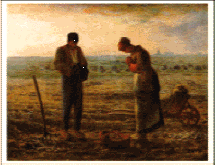


"They confessed that they were STRANGERS and PILGRIMS on the earth." -- (Hebrews 11:13)
Is it possible to know we are born again? Has God left us to grope in the dark, or has He given us certain distinguishing characteristics by which we may settle doubts?
In His First Epistle, the Apostle John gives several marks that identify true believers. Since it is an encyclical letter, the themes that are introduced in chapter one, recur in chapter two, are expanded in chapter three, further developed in chapter four and are summarized in chapter five.
 First,
"Hereby we do that we know Him, if we keep His commandments. He that
saith ‘I know Him,’ and keepeth not His commandments is a liar, and
the truth is not in him. But whoso keepeth His word, in him verily
is the love of God perfected: hereby know we that we are in Him." (I
John 2:3-6)
First,
"Hereby we do that we know Him, if we keep His commandments. He that
saith ‘I know Him,’ and keepeth not His commandments is a liar, and
the truth is not in him. But whoso keepeth His word, in him verily
is the love of God perfected: hereby know we that we are in Him." (I
John 2:3-6)
Friend, you say you love the Lord; but do you love Him enough to obey Him? The Lord Jesus declares, "He that hath My commandments and keepeth them, he it is that loveth Me." (John 14:21) Obedience is the most basic evidence a person truly loves God. They who are really converted are not saved "to live unto themselves, but unto Him which died for them and rose again." (II Corinthians 5:15)
Second, "We know that we have passed from death unto life, because we love the brethren." (I John 3:14) The person who has been born again loves everyone who loves the Lord. Instead of choosing his
friends from among blasphemers and haters of God, his friends adore the Lord. Neither does he love in word only, but in deed and in truth. He bears their burdens, weeping with them that weep and rejoicing with them that do rejoice.
Third, the person who is saved loves God to such a degree that he loathes the world. The Apostle warns, "If any man love the world, the love of the Father is not in him."(I John 2:15) A saved individual knows the whole world "lieth in wickedness" (5:19), and by this knowledge he knows he is born of God. The people whose heart is yet in the world have not this knowledge. If a person is of this world, the world will love him, but because the man of God is not of this world, therefore the world hateth him.
Fourth, "We are of God: he that knoweth God heareth us; he that is not of God heareth not us. Hereby know we the spirit of truth and the spirit of error. (I John 4:6) The preaching of God’s Word will either draw people or drive them. They who love it will gravitate to it. They consider it of greater value than "thousands of gold and silver;" sweeter to the soul’s palate than "honey and the honeycomb." (Psalm 119:72; 19:10) But it will scatter all others. They may endure for a while, but when "tribulation or persecution arises because of the Word, by and by they are offended." (Matthew 13:21)
Fifth, "He that believeth on the Son of God hath the witness in himself." (I John 5:10) The person who is really born again does not need to convince himself he is saved, He does not need to talk himself into a state of salvation, but will have "the witness in himself." "And hereby we do know that we know Him." (2:3) "Hereby know we that we are in Him." (2:5) "And hereby know that we are of the Truth and shall assure our hearts before Him." (3:19) "And hereby know that He abideth in us." (3:24) "Hereby know we that we dwell in Him and He in us." (4:13) (See 5:11-13)
Sixth, "Whosoever is born of God does not commit sin; for His seed remaineth in him: and he cannot sin, because he is born of God." (I John 3:9) He who is born of God cannot continue a state of sin because he is born again --born from on high. God has not eradicated his evil nature, nor refined it, but has imparted a new nature --one that loathes sin and delights in what is good. He is thus saved from the Pleasures of sin.
Reader, it is vain for a person to argue he has been born again so long as his heart is in the world. It is foolish to pretend he is a changed person when he still has no love for the things of God.
THE AUTHENTICITY OF THE LAST TWELVE VERSES
OF THE GOSPEL ACCORDING TO MARK --II
demonstrated by the evidence of the ancient manuscripts
The New Testament was translated at a very early period into Syriac, Latin, Gothic, Egyptian, etc. Some of these translations were made from Greek copies more ancient than any we now possess. They can therefore tell us what scholars found in their N. T. before the time of our oldest manuscripts. In the Peshito Syriac of the 2nd century, the ‘Curetonian’ Syriac of the 3rd century, the ‘Philoxenian’ Syriac of the 5th century; Jerome’s Latin of the 4th; the Old Latin of the 2nd; the Gothic of the 4th; the Egyptian of the 4th or 5th; the Thebaic of the 3rd; some copies of the Armenian of the 5th century; --in all these ancient translations we have evidence that the translators found the disputed verses in the Greek copies available to them. Most of those ancient translations were made long before the Vatican and Sinai copies were written. The Greek copies used by the translators in the 2nd and 3rd centuries contained the last twelve verses, while the Greek copies used by the Vatican and Sinai copyists in the 4th century were complete.
The great majority of the manuscripts contain the disputed words, but two very ancient copies omit them, namely the Codex Vaticanus and the Codex Sinaiticus, both of the 4th century. A 19th century scholar examined 20 ancient uncial manuscripts and about 600 cursives and found these 2 only at variance with the Received Text.
Codex Alexandrinus and Codex C, perhaps 50 years later than the 2 already mentioned, contain these verses. Codex Bezae (D), often in agreement with the 2 defective MSS, parts company with them here and includes the verses. It is clear that the Sinai and Vatican MSS exhibit a mutilated text in this place, as they do in many other passages.
These two MSS though ancient are in many respects defective and untrustworthy, carelessly written with numerous omissions. The Vatican Manuscript in the Gospels alone omits words and clauses 1,491 times and the largest proportion of these is found in Mark. The Codex Sinaiticus abounds with "errors of the eye and pen to an extent not unparalleled, but happily unusual in documents of first rate importance." These 2 documents exhibit signs of a common origin in an earlier defective copy.
The Vatican copy stops short at the end of verse 8, but the copyist left a blank space sufficient to accommodate the missing verses. It seems likely that the copyist knew that there portion missing in the copy before him.
In the Sinai copy the double page containing the end of Mark and beginning of Luke was removed at an early date and replaced with the four sides re-written to exclude Mark 16:9-20. By slightly increasing the size of the letters and spaces the writer was able to extend his shortened version to the top of the column preceding Luke 1. He filled in the remainder of his last line with an ornamental flourish to make sure that no addition could be made without being immediately evident. Tischendorf, the discoverer of the Sinai copy, alleged that these pages were written by the copyist of the Vatican manuscript. The evidence does no more than indicate that a few early manuscripts terminated in this way, but that the copyists themselves were conscious of the omission. These two manuscripts are shown to be false witnesses.
The critics assure us that many ancient mss contain a note stating that Mark 16:9-20 was missing from many other copies. Scholars have been found to quote their predecessors without verifying their accuracy. Thus Tregelles alleges that in 23 copies a note states that these verses are missing from the "most correct" copies. This statement seems to have been quoted second hand from Griesbach and Scholz, 1830. Scholz misquoted Griesbach and Griesbach misquoted Wetstein, 1751, and Birch. e.g. Scholz copies Griesbach, who says 2 mss at Rome have an asterisk against Mark 16:9-20. Investigations show that there is not an asterisk, but a cross referring the reader to a note on another page, where there is a similar mark where it is plainly stated that the passage is genuine. There is also a note stating that the text had been collated with the ancient and approved copies at Jerusalem.
--To Be Continued. Next month: "The Argument from Style and Vocabulary" (Reprinted with permission from The Trinitarian Bible Society, 217 Kingston Road, London SW 19 3NN, England, through its Canadian branch at 26 Gracey Blvd., Weston, Ontario, M9R 1Z9)